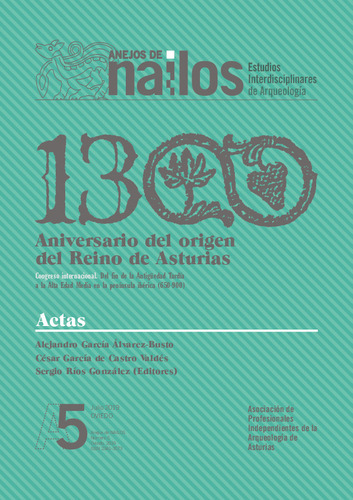Aproximación al taller artesanal metalúrgico del castillo de Gauzón (Castrillón, Asturias). Arqueología de la producción en el reino de Asturias
Autor(es) y otros:
Fecha de publicación:
Editorial:
Asociación de Profesionales Independientes de la Arqueología de Asturias
Citación:
Descripción física:
Resumen:
Las excavaciones arqueológicas desarrolladas en el castillo de Gauzón (Castrillón, Asturias) han permitido identificar un espacio de trabajo artesanal en el cual funcio-nó un taller dedicado a la metalurgia entre los siglos IX y X d. C. El estudio de esta zona ha sido planificado desde una perspectiva microespacial, considerándola casi como un yacimiento dentro del propio yacimiento, con una naturaleza específica en el conjunto de la fortaleza, y ahondando de esta manera en un ámbito analítico de la misma poco conocido hasta el momento. Este enfoque ha permitido retratar por primera vez con minuciosidad un episodio productivo trascendente, encuadrado en el período en el cual los reyes de Asturias reconstruyen y monumentalizan el baluar-te tardoantiguo, convirtiéndolo en símbolo de prestigio de la monarquía y solar en el que se elaboró la Cruz de la Victoria. En este trabajo se realiza un acercamiento des-de una perspectiva investigadora que combina los datos de campo y las reflexiones contextuales, atendiendo a la articulación espacial del taller y su relación con otros ámbitos del castillo, a los trabajos desempeñados en el mismo, y al ambiente palati-no que lo envuelve, y que, en gran medida, lo dota de sentido, en el marco de una so-ciedad y un modo de vida donde funcionalidad y suntuosidad se dan la mano.
Las excavaciones arqueológicas desarrolladas en el castillo de Gauzón (Castrillón, Asturias) han permitido identificar un espacio de trabajo artesanal en el cual funcio-nó un taller dedicado a la metalurgia entre los siglos IX y X d. C. El estudio de esta zona ha sido planificado desde una perspectiva microespacial, considerándola casi como un yacimiento dentro del propio yacimiento, con una naturaleza específica en el conjunto de la fortaleza, y ahondando de esta manera en un ámbito analítico de la misma poco conocido hasta el momento. Este enfoque ha permitido retratar por primera vez con minuciosidad un episodio productivo trascendente, encuadrado en el período en el cual los reyes de Asturias reconstruyen y monumentalizan el baluar-te tardoantiguo, convirtiéndolo en símbolo de prestigio de la monarquía y solar en el que se elaboró la Cruz de la Victoria. En este trabajo se realiza un acercamiento des-de una perspectiva investigadora que combina los datos de campo y las reflexiones contextuales, atendiendo a la articulación espacial del taller y su relación con otros ámbitos del castillo, a los trabajos desempeñados en el mismo, y al ambiente palati-no que lo envuelve, y que, en gran medida, lo dota de sentido, en el marco de una so-ciedad y un modo de vida donde funcionalidad y suntuosidad se dan la mano.
The archaeological excavation of the castle of Gauzón (Castrillón, Asturias) has allowed to identify an artisan workshop dedicated to metallurgy operating between the 9th and 10th centuries AD. The study of this area has been planned from a mi-cro-spatial perspective, almost as an archaeological site within the site itself, with a specific nature of work inside the fortress, and deepening in this way in an analytical framework little known until now. This approach has allowed us to portray for the first time a transcendent productive episode, framed in the period in which the kings of Asturias reconstruct and monumentalize the Late Antiquity settlement, turning it into a symbol of the prestige of the monarchy, and the site where the Victory Cross was elaborated. In this study, an approach is made from a research perspective that combines the archaeological records and contextual analysis, in regard to the spa-tial articulation of the artisan workshop and its relationship with other areas of the castle, the metallurgical works performed on it and the palatial environment that su-rrounds it, and gives it meaning, all this within the framework of a society and a way of life where functionality and sumptuousness come together.
The archaeological excavation of the castle of Gauzón (Castrillón, Asturias) has allowed to identify an artisan workshop dedicated to metallurgy operating between the 9th and 10th centuries AD. The study of this area has been planned from a mi-cro-spatial perspective, almost as an archaeological site within the site itself, with a specific nature of work inside the fortress, and deepening in this way in an analytical framework little known until now. This approach has allowed us to portray for the first time a transcendent productive episode, framed in the period in which the kings of Asturias reconstruct and monumentalize the Late Antiquity settlement, turning it into a symbol of the prestige of the monarchy, and the site where the Victory Cross was elaborated. In this study, an approach is made from a research perspective that combines the archaeological records and contextual analysis, in regard to the spa-tial articulation of the artisan workshop and its relationship with other areas of the castle, the metallurgical works performed on it and the palatial environment that su-rrounds it, and gives it meaning, all this within the framework of a society and a way of life where functionality and sumptuousness come together.
Ficheros en el ítem





